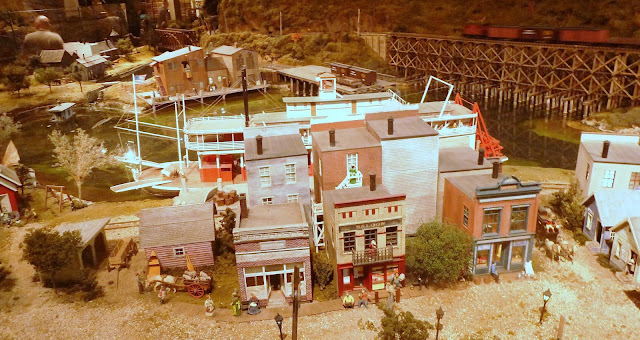Hamley’s of London used to have a wonderful train system placed right across the central section of the world famous toy store. On many occasions over the past few decades, I used to stand and just admire its intricate railroad system with the numerous carriages and accoutrement's which go with a rail system. Its where i got my Triang train set at a young age. Regrettably as people’s interests change, the display got smaller and smaller, till in 2014, it no longer exists. However, I was in for a real big surprise when I went to the American Rail Roading Museum in Cincinnati.
Like most American displays, it is VAST. The 25,000
sq ft train layout was constructed by 130 volunteers headed by the Greater Cincinnati
Garden Railway Society. The basic scenery consists of sprayed on
polyurethane foam that was carved and painted. All the buildings, bridges,
other structures, trees, and the zillion other scenic details were built by the
volunteers themselves from scratch!! Awesome does not describe the feeling when
you walk around the whole display. There are thousands of miniature people painstakingly
modified and painted. Over 60,000 man hours have been spent so far. And this
was just the beginning ... there is always some work going on.
There is wonderfully explained map of the whole display. Basically it takes you through the different scenarios where the rail networks went. It also shows you the origins of how each type of the railway system evolved right from the times of the Civil War.
Beginning with saw mills which were located near forests supplied saw logs turned later into finished lumber for construction or other uses – furniture, floorings, staves, shingles etc.
In the Civil war section, you see examples of
supply bases. There is a large trestle based on the one running over Potomac Creek
which had been built by the Union troops in 1862. You see the charred timbers
of the original one burnt by the rebels. This replacement structure was
completed in just 9 days using whatever material was available.
One aspect which strikes the viewer is the
numerous bridges. There are over 100 bridges and trestles on display. Each has
been custom built after painstaking research on the original version.
Railway stations were built on the property of
landowners and hence the station got its name. Here in the display, this
station is named Baxter, after the volunteer who made all the structures incl.
the water tank and the two depots!!


 When trains had to cross navigable streams, drawbridges and swing bridges were used for safe passage of boats. There is a bridge patterned after the one over Harlem River in New York, late 1800’s. The counterbalanced bridge was aside and lowered using a steam winch. There was also a bridge tender 24x7.
When trains had to cross navigable streams, drawbridges and swing bridges were used for safe passage of boats. There is a bridge patterned after the one over Harlem River in New York, late 1800’s. The counterbalanced bridge was aside and lowered using a steam winch. There was also a bridge tender 24x7. Museum Volunteer Peter Villareal who created this bridge individually pre-drilled holes and inserted 4,200 nail pins to represent rivets. Do you have that sort of patience ??
Railroads had their own repair facilities for locos and rolling stock. They made their own replacement parts. Hence foundries, blacksmiths, carpenters, boiler shops and related occupations all congregated together. This led to development of townships , gradually.
How did railroads staff signal to each other? Various methods were used. In the early days, one method was the raising and lowering of brightly painted coloured balls. (by day) and lanterns (by night). A lowered ball indicated the train should stop. The raised ball meant track was clear and proceed - hence the expression "high ball"!
I am not going to give more details on this museum as there are far too many sections - technical areas, coal mining trains, urban trains, types of rolling stock, types of engines and how they were designed, the different types of passenger cars and passengers over the ages!! So, just enjoy the photographs of the museum.

Details of the engine above


Just look at the detailing here.
and these are the famous Americans who still love the model railroads - reminiscences of their childhood!!
and finally a few facts of this amazing museum . Hope you liked the blog.
Text and photographs copyright of the author. No part of this article or photographs maybe transmitted or reproduced by any means, electronic, mechanical, photocopying or otherwise, without written permission. Do contact the author on email -- helpthesun@gmail.com































No comments:
Post a Comment
Text and photographs are copyright of the author. No part of any article or photographs maybe transmitted or reproduced by any means, electronic, mechanical, photocopying or otherwise, without written permission. Do contact the author on email -- helpthesun@gmail.com